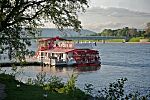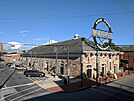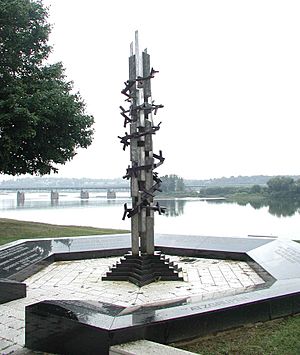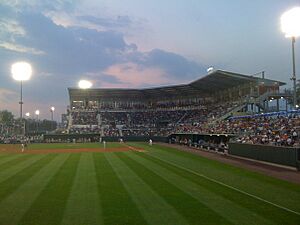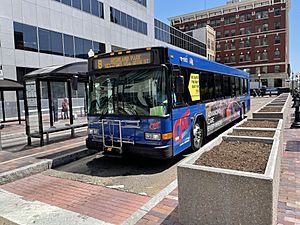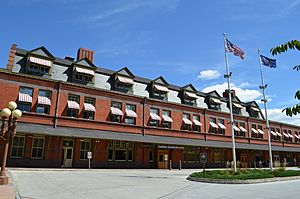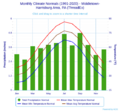Harrisburg, Pennsylvania facts for kids
Quick facts for kids
Harrisburg
|
|||||
|---|---|---|---|---|---|
|
Harrisburg skyline
Pride of the Susquehanna
|
|||||
|
|||||
| Country | |||||
| State | Pennsylvania | ||||
| County | Dauphin | ||||
| European settlement | c. 1719 | ||||
| Incorporated | 1791 | ||||
| Charter | March 19, 1860 | ||||
| Founded by | John Harris, Jr. | ||||
| Named for | John Harris, Sr. | ||||
| Government | |||||
| • Type | Mayor-Council | ||||
| Area | |||||
| • City | 11.86 sq mi (30.73 km2) | ||||
| • Land | 8.12 sq mi (21.03 km2) | ||||
| • Water | 3.75 sq mi (9.70 km2) | ||||
| • Urban | 259.7 sq mi (672.6 km2) | ||||
| Elevation | 335 ft (102 m) | ||||
| Population
(2020)
|
|||||
| • City | 50,099 | ||||
| • Estimate
(2022)
|
50,183 | ||||
| • Density | 6,174.26/sq mi (2,383.98/km2) | ||||
| • Urban | 490,859 (US: 86th) | ||||
| • Urban density | 1,961.5/sq mi (757.3/km2) | ||||
| • Metro | 591,712 (US: 98th) | ||||
| • CSA | 1,295,259 (US: 46th) | ||||
| Demonym(s) | Harrisburger, Harrisburgian | ||||
| Time zone | UTC−5 (EST) | ||||
| • Summer (DST) | UTC−4 (EDT) | ||||
| ZIP Codes |
17101-17113, 17120-17130, 17140, 17177
|
||||
| Area code | 717 and 223 | ||||
| FIPS code | 42-32800 | ||||
| GNIS feature ID | 1213649 | ||||
| Interstates | I-76, I-81, I-83 and I-283 | ||||
| Waterways | Susquehanna River | ||||
| Primary Airport | Harrisburg International Airport- MDT (Major/International) | ||||
| Secondary Airport | Capital City Airport- CXY (Minor) | ||||
| Public transit | Capital Area Transit | ||||
|
Pennsylvania Historical Marker
|
|||||
| Designated: | September 23, 1946 | ||||
Harrisburg is the capital city of Pennsylvania, a state in the United States. It is also the main city of Dauphin County. About 50,099 people lived there in 2020, making it the ninth-largest city in Pennsylvania. Harrisburg is located on the east bank of the Susquehanna River.
This city has played an important part in American history. It was key during the American Civil War and the Industrial Revolution. For a long time, building canals and railroads helped Harrisburg become a major industrial city in the Northeastern U.S. Today, its economy is stable because many state and federal government offices are located there.
Harrisburg hosts the Pennsylvania Farm Show, which is the biggest indoor agriculture event in the U.S. It also hosts the Great American Outdoor Show, the largest outdoor recreation show in the world. In 1979, the Three Mile Island accident happened near Harrisburg.
Contents
History of Harrisburg
Early Settlements and Founding
The area where Harrisburg is now was first home to Native Americans around 3000 BC. They called it "Peixtin" or "Paxtang". It was an important meeting point for traders. Trails from the Delaware, Ohio, and Potomac rivers all met here.
In 1608, Captain John Smith was the first European to meet Native Americans in Pennsylvania. He traveled up the Susquehanna River and met the Susquehanna tribe.
In 1719, an English trader named John Harris, Sr. settled in the area. His son, John Harris, Jr., planned to create a town on his father's land in 1785. He named it Harrisburg. The town was officially surveyed by William Maclay, who was John Harris, Sr.'s son-in-law. Harrisburg became an official town in 1791. In 1812, it was chosen to be the capital of Pennsylvania, and it has been ever since.
Harrisburg in the 19th Century
Before Harrisburg became an industrial city, it was a quiet town surrounded by farms. In 1822, a large brick capitol building was finished. Harrisburg's location was very important because it was a trading post on the way to the west. People traveling west by boat on the Susquehanna River would stop here before continuing their journey overland. This is why it became the state capital in 1812.
During the early 1800s, Harrisburg was a significant stop on the Underground Railroad. People escaping slavery would use the Susquehanna River to find food and supplies before heading north to Canada.
During the American Civil War, Harrisburg was a major training center for the Union Army. Thousands of soldiers passed through Camp Curtin. It was also a key railroad hub, connecting the Atlantic coast to the Midwest. Because of this, Robert E. Lee's Confederate Army tried to capture Harrisburg twice. In 1863, Confederate forces advanced close to the city but were stopped by Union defenses. This was the farthest north the Confederate Army reached during the war.
After the Civil War, Harrisburg became very important for the steel industry. Many large steel mills and foundries were built nearby, especially in Steelton. The Pennsylvania Steel Company opened the first steel mill in the country in Steelton in 1866. These industries brought many jobs and people to the area.
The railroad system also grew a lot. The Pennsylvania Railroad had huge repair facilities and passenger stations in Harrisburg. Trains connected Harrisburg to cities like Pittsburgh and Philadelphia.
Allison Hill, Harrisburg's first suburb, grew in the late 1800s. It offered a place for wealthy residents to live close to the city. Trolley lines and bridges made it easy to get to and from the city center.
Harrisburg in the 20th Century
In the early 1900s, Harrisburg needed improvements. Diseases like typhoid were a problem due to poor sanitation. Local leaders, inspired by the "City Beautiful" movement, worked to improve the city. They created more parks, like Riverfront Park and Italian Lake. They also improved the water system, paved roads, and built a modern sewer system. A new, grand Capitol building was also built in 1906.
From the 1920s to the 1970s, Harrisburg saw its industries decline. Many people moved from the city to the suburbs. The city's economy shifted towards services like healthcare and convention centers.
The Pennsylvania Farm Show started in 1917 and has been held every January since. It is the largest indoor agriculture show in the U.S.
On March 28, 1979, the Three Mile Island nuclear plant, located south of Harrisburg, had a partial meltdown. Even though the radiation leaks were small, many people were worried. The governor advised pregnant women and young children to leave the area. About 140,000 people left within a few days.
Stephen R. Reed was mayor from 1981 to 2009. He worked to bring new businesses and tourism to the city. Many museums, hotels, and office buildings were built during his time. Professional sports teams, like the Harrisburg Senators baseball team, also started playing in the city.
Harrisburg in the 21st Century
In the early 2000s, Harrisburg faced financial challenges. The city had a lot of debt, partly from a trash-to-electricity plant that cost more than expected.
In 2011, Harrisburg tried to file for bankruptcy, but a judge stopped it. Instead, the state government took over the city's finances to help fix the problems. After a few years, a plan was approved to help the city manage its debt. Harrisburg sold the incinerator and leased its parking garages to help pay off what it owed. By the late 2010s, the city's budget was balanced and even had a surplus.

Geography and Climate
Where is Harrisburg Located?
Harrisburg is in South Central Pennsylvania. It is about a two-hour drive from cities like Baltimore, Washington, and Philadelphia. The city covers about 11.4 square miles (30.73 square kilometers). Most of this is land, but about 3.3 square miles (9.70 square kilometers) is water, including parts of the Susquehanna River. Harrisburg is one of the smallest state capital cities in the U.S.
North of Harrisburg are the Blue Mountain ridges of the Appalachian Mountains. The Cumberland Valley is to the west, and the fertile Lebanon Valley is to the east. Harrisburg is also at the northern edge of the famous Pennsylvania Dutch Country.
Harrisburg is the county seat of Dauphin County. It is surrounded by other counties like Northumberland, Schuylkill, Lebanon, Lancaster, York, Cumberland, and Perry.
Neighboring Towns and Areas
Harrisburg's western border is the Susquehanna River. This river also separates Dauphin and Cumberland counties. Many towns and townships near Harrisburg use "Harrisburg" in their postal addresses, even if they are separate places. These include Lower Paxton, Middle Paxton, Susquehanna, Swatara, and West Hanover.
Some nearby boroughs like Penbrook and Paxtang also share Harrisburg's ZIP codes.
Weather in Harrisburg
Harrisburg has four distinct seasons. Summers are usually hot and humid, with temperatures sometimes reaching 90°F (32°C) or higher. The hottest temperature ever recorded was 107°F (42°C) in July 1966. Thunderstorms are common in summer.
Autumn is pleasant, with cooler temperatures and less humidity. Winters are mild to cool, with January being the coldest month. The average temperature in January is around 32.6°F (0.3°C). Snowfall varies each winter; some years have a lot of snow, while others have very little. The most snow in one day was 26.4 inches (67 cm) in January 2016. The coldest temperature ever recorded was -22°F (-30°C) in January 1994. Spring is also a nice time for outdoor activities. Rain is spread out throughout the year, with July usually being the wettest month.
City Life and Buildings
Harrisburg's Neighborhoods
Downtown Harrisburg is the main business and financial area. It is also where the government offices for Dauphin County and Pennsylvania are located. The city has many neighborhoods and historic districts.
Cool Buildings and Design
Harrisburg has buildings that show over 200 years of different architectural styles. The city has special historic districts to protect these unique areas.
The Pennsylvania State Capitol building is a famous landmark. It was finished in 1906. Its central dome is 272 feet (83 meters) tall and was inspired by St. Peter's Basilica in Rome. The building has beautiful sculptures and murals. While the Capitol is very grand, it is not the tallest building in Harrisburg. The tallest buildings are 333 Market Street (341 ft), Pennsylvania Place (291 ft), Presbyterian Apartments (259 ft), and the Fulton Bank Building (255 ft).
People and Culture
Population and Diversity
The first census in the U.S. in 1790 showed Harrisburg had 875 residents. The city's population grew a lot as it became an industrial and transportation center. It reached its highest population in 1950 with almost 90,000 residents. Since then, like many cities in the northeastern U.S., Harrisburg's population has decreased as people moved to the suburbs. However, this decline has slowed down since the 1980s.
Harrisburg is a diverse city. The largest ethnic groups include African American, German, Irish, and Italian. It has one of the largest Pennsylvania Dutch communities in the country.
What People Do for Work
Harrisburg is a central hub for about 400 communities. Its economy is varied, with many jobs in service industries, especially healthcare. The city also has growing technology and biotechnology industries. Being the state capital, government jobs are a big part of the economy. Large companies like Ahold Delhaize, HP Inc., IBM, Hershey Foods, and Rite Aid Corporation have major operations here. The federal and state governments are the biggest employers, which helps keep the economy stable. Harrisburg's good transportation system also makes it a key center for trade and distribution.
Major Employers
Here are some of the top employers in the Harrisburg area:
- Commonwealth of Pennsylvania (state government)
- United States Federal government (including the military)
- Giant Food Stores (grocery store chain)
- Penn State Hershey Medical Center (hospital and medical research)
- Hershey Entertainment and Resorts (amusement parks)
- The Hershey Company (food manufacturer)
- Wal-Mart Stores, Inc. (retail store chain)
- Highmark (health insurance)
- TE Connectivity (electronic parts manufacturer)
- UPMC Pinnacle (healthcare and hospital system)
Arts and Entertainment
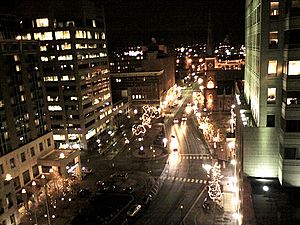
In the mid-1900s, Harrisburg had many nightclubs and places for performances. Famous jazz musicians like Duke Ellington and Dizzy Gillespie played here.
Today, several groups support the arts. The Art Association of Harrisburg offers classes and shows. The Susquehanna Art Museum also has classes, exhibits, and community events.
Downtown Harrisburg has two main performance centers. The Whitaker Center for Science and the Arts, built in 1999, is special because it combines education, science, and performing arts in one building. The Forum, a large concert hall built in 1930–31, is home to the Harrisburg Symphony Orchestra. Other places for performances include The Capitol Room, Open Stage of Harrisburg, and Gamut Theatre Group.
Since 2001, downtown Harrisburg has seen a growth in nightlife. This has helped the city's economy and made downtown a popular spot for events, from jazz festivals to nightclubs. In 2004, Harrisburg hosted CowParade, a public art exhibit where local artists decorated fiberglass cow sculptures placed around the city.
Fun Events in Harrisburg
Harrisburg hosts many large events throughout the year that attract visitors from all over.
- The annual gathering of the Ahmadiyya Muslim Community USA is held in Harrisburg every July.
- The Pennsylvania Farm Show is the largest agricultural exhibition of its kind in the nation. Farmers show their animals and compete.
- The Great American Outdoor Show, the world's largest outdoor recreation show, happens every February. It has demonstrations, seminars, and a country music concert.
- Motorama, the nation's largest indoor motorsports event, is held annually.
- The Ice & Fire Festival in March features ice sculptures, fire dancers, food trucks, and ice skating.
- The Pennsylvania Auto Show is held every year.
- ArtsFest in the spring features artists and craftspeople selling unique items.
- Pride Festival of Central PA is a three-day annual LGBT pride event.
- The Antique Fire Apparatus Show & Muster displays old and new fire engines.
- Harrisburg's Independence Day Celebration has food, live music, and fireworks.
- Kipona Festival, held every Labor Day Weekend, celebrates the Susquehanna River with food, fireworks, music, and canoe races.
- The Greenbelt's Tour de Belt is a weekend of bike events.
- Cultural Fest celebrates the area's diverse cultures.
- The Riverfront Park Concert Series features national music acts in the summer.
- The Harrisburg Marathon runs along the riverfront each fall.
- WoofStock in September celebrates dogs with music, food, and prizes. It is the largest pet adoption event on the East Coast.
- BrewFest in October features local craft beers.
- Harrisburg's New Year's Eve Celebration has live music, activities, and fireworks.
News and Media
The Harrisburg area is part of a larger media market that includes Lancaster, Lebanon, and York. It is the 43rd largest media market in the U.S.
Several newspapers serve the Harrisburg area:
- The Patriot-News
- Central Penn Business Journal
- Press and Journal (Pennsylvania)
- Carlisle Sentinel
There are also many TV and radio stations.
Television Stations
- WGAL – (NBC)
- WXBU – (Univision)
- WHBG-TV – public access
- WHP-TV – (CBS/MyNetworkTV/CW)
- WHTM-TV – (ABC)
- WCZS-LD – (CTVN)
- WITF-TV – (PBS)
- WPMT – (Fox)
- WLYH – independent, religious
- PCN-TV – covers government and public affairs
- Roxbury News – independent news
Radio Stations (FM)
- WDCV (88.3 FM) – Indie/College Rock
- WXPH (88.7 FM) – WXPN relay
- WSYC (88.7 FM) – Alternative
- WITF-FM (89.5 FM) – NPR
- WVMM (90.7 FM) – Indie/College Rock
- WJAZ (91.7 FM) – Classical/Jazz
- WKHL (92.1 FM) – Contemporary Christian
- WPPY (92.7 FM) – Adult Contemporary
- WTPA-FM (93.5 FM) – Classic Rock
- WRBT (94.9 FM) – Country
- WLAN (96.9 FM) – CHR
- WRVV (97.3 FM) – Classic Rock
- WYCR (98.5 FM) – Classic Hits
- WQLV (98.9 FM) – Hot AC
- WHKF (99.3 FM) – Urban Contemporary
- WFVY (100.1 FM) – Country
- WROZ (101.3 FM) – Christian Contemporary
- WARM (103.3 FM) – Hot AC
- WNNK (104.1 FM) – Hot AC
- WQXA (105.7 FM) – Active Rock
- WWKL (106.7 FM) – Rhythmic CHR
- WGTY (107.7 FM) – Country
Radio Stations (AM)
- WHP (AM) (580 AM) – News/Talk
- WHYF (720 AM) – Catholic Radio
- WSBA (AM) (910 AM) – News/Talk
- WADV (940 AM) – Gospel
- WHYL (960 AM) – Adult Standards
- WIOO (1000 AM) – Classic Country
- WKBO (1230 AM) – Christian Contemporary
- WQXA (1250 AM) – Country
- WLBR (1270 AM) – Talk
- WHGB (1400 AM) – ESPN Radio
- WTKT (1460 AM) – Sports
- WRDD (1480 AM) – Country
- WRKY (1490 AM) – Classic Rock
- WPDC (1600 AM) – Sport
- Penndot (1670 AM) – Weather and Travel
Museums and Fun Places to Visit
- Broad Street Market: One of the oldest continuously running farmers markets in the U.S.
- Dauphin Narrows Statue of Liberty: A small replica of the Statue of Liberty on the Susquehanna River.
- Fort Hunter Mansion and Park: A historic home and park overlooking the Susquehanna River.
- Harrisburg Doll Museum: Home to over 5,000 dolls and toys.
- John Harris – Simon Cameron Mansion: A historic landmark along the river.
- Market Square: The central point of downtown Harrisburg.
- Midtown Scholar Bookstore: The largest independent bookstore on the East Coast.
- National Civil War Museum: Located at Reservoir Park and connected to the Smithsonian Institution.
- Pennsylvania National Fire Museum: Learn about firefighting history.
- Pennsylvania Farm Show Complex & Expo Center: A huge convention center that hosts many events, including the Farm Show.
- Pennsylvania State Capitol Complex: The center of state government, including the state capitol building and state libraries.
- Pride of the Susquehanna paddle-wheel riverboat: Offers tours on the Susquehanna River.
- State Museum of Pennsylvania: Features a planetarium and a mastodon fossil.
- Strawberry Square: A shopping center and office building across from the Capitol.
- Susquehanna art museum: A recently renovated art museum in Midtown.
- Art Association of Harrisburg: Offers art education and exhibits.
- Whitaker Center for Science and the Arts: Has a science center and an IMAX theater.
- Zembo Shrine Building: A building with unique Moorish Revival architecture.
Parks and Outdoor Fun
Harrisburg has many great parks for outdoor activities:
- Capital Area Greenbelt: A 20-mile (32 km) long path for biking and walking. It connects many city neighborhoods and parks.
- City Island and Beach: An island in the Susquehanna River with a beach and recreational areas.
- Italian Lake: A beautiful park in the Uptown neighborhood.
- Paxtang Park: A historic park with mountain bike trails.
- Reservoir Park: The city's largest public park with an amphitheater.
- Riverfront Park: A park along the Susquehanna River.
- Wildwood Lake Park: A park with a lake for nature lovers.
Sports Teams
Harrisburg is a center for professional sports in South Central Pennsylvania. It has several teams, including three professional baseball teams: the Harrisburg Senators, the Lancaster Stormers, and the York Revolution.
The Harrisburg Senators are the oldest team, playing since 1987. The original Senators team played in the Eastern League starting in 1924. They won championships in 1927, 1928, and 1931. Their home field was destroyed by floods in 1936. The current Harrisburg Senators, who are linked with the Washington Nationals, have won the Eastern League championship six times.
Here are some of the sports teams in the Harrisburg area:
- Harrisburg Senators (Eastern League, Baseball)
- Hershey Bears (AHL, Ice hockey)
- Penn FC (USL, Soccer)
- Harrisburg Heat (MASL, Indoor soccer)
- Keystone Assault (WFA, Women's football)
- Harrisburg Lunatics (PIHA, Inline hockey)
- Harrisburg RFC (EPRU, MARFU, Rugby)
- Harrisburg Stampede (NAL, Arena Football)
Getting Around Harrisburg
Airports for Travel
You can fly to and from Harrisburg through Harrisburg International Airport (MDT). It is located southeast of the city in Middletown. This airport is the third busiest in Pennsylvania for both passengers and cargo. Many people also use larger airports in nearby cities like Baltimore or Philadelphia. Airlines like American Airlines, United Airlines, and Delta Air Lines serve Harrisburg.
Capital City Airport (CXY) is a smaller airport for business and private planes. It is located across the Susquehanna River in New Cumberland. Both airports are managed by the Susquehanna Area Regional Airport Authority (SARAA).
Buses and Public Transport
Harrisburg has a public bus system called Capital Area Transit (CAT). It provides bus service throughout the Harrisburg area. There have been plans to build a commuter train line to connect Harrisburg with nearby cities like Lancaster, but these plans are currently on hold.
The Harrisburg Transportation Center is where intercity buses stop. Companies like Greyhound and Capitol Trailways offer daily bus services. You can travel to other Pennsylvania cities like Philadelphia and Pittsburgh, or to nearby states like Maryland and New York.
Trains and Railroads
Harrisburg has always been an important railroad city. The Pennsylvania Railroad's main line from New York to Chicago passed through Harrisburg. Today, Norfolk Southern operates freight trains in the Harrisburg area. They have large yards for transferring goods between trains and trucks.
Amtrak provides passenger train service to Harrisburg. The Keystone Service and Pennsylvanian routes run daily between New York, Philadelphia, and the Harrisburg Transportation Center. The Pennsylvanian train also continues west to Pittsburgh. Improvements to the train tracks between Harrisburg and Philadelphia mean trains can now travel faster, making the trip shorter. The Harrisburg Transportation Center is one of the busiest Amtrak stations in Pennsylvania.
Roads and Bridges
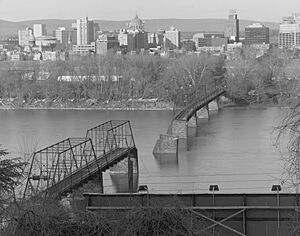
Several major highways serve Harrisburg. Interstate 76 (the Pennsylvania Turnpike) passes south of the city, connecting to Pittsburgh and Philadelphia. Interstate 81 runs north of Harrisburg, heading southwest towards Carlisle and northeast towards Hazleton. Interstate 83 goes through the center of Harrisburg, heading south towards York and Baltimore. These interstates, along with Pennsylvania Route 581, form the Capital Beltway that circles Harrisburg.
Harrisburg has many large bridges that cross the Susquehanna River. Some other important bridges span Paxton Creek and Cameron Street, connecting downtown with other neighborhoods. The Walnut Street Bridge is now only used by people walking and biking. Part of it is missing on the western side due to flooding from a blizzard in 1996.
Education
Public Schools
Harrisburg is served by the Harrisburg School District. It provides education from kindergarten through twelfth grade. SciTech High, a special school for math and science, opened in 2003 and is connected to Harrisburg University.
There are also several public charter schools in the city, such as Infinity Charter School and Capital Area School for the Arts. The Central Dauphin School District, one of the largest in Pennsylvania, also serves areas with Harrisburg postal addresses.
Private Schools
Harrisburg has many private schools, including a large Catholic school system. The Roman Catholic Diocese of Harrisburg oversees nearly 40 elementary schools and seven high schools in the region, like Bishop McDevitt High School. Other private schools include The Londonderry School and The Circle School, which is a unique Sudbury Model school. Harrisburg Academy, founded in 1784, is one of the oldest independent schools in the nation.
Colleges and Universities
Harrisburg is home to several colleges and universities:
- Association of Independent Colleges and Universities of Pennsylvania (AICUP) is headquartered downtown.
- Dixon University Center (now closed) was the main office for the Pennsylvania State System of Higher Education (PASSHE), one of the largest university systems in the U.S.
- Harrisburg Area Community College: The main campus and other branches are located in Harrisburg.
- Harrisburg University of Science and Technology: Located downtown.
- Messiah College's Harrisburg Institute: Located downtown.
- Penn State Harrisburg Eastgate Center: Located downtown.
- Temple University Harrisburg Campus: Located downtown.
- Widener University Commonwealth Law School
Libraries for Learning
Harrisburg has many libraries:
- Dauphin County Law Library
- Dauphin County Library System: With eight branches in Harrisburg and nearby areas.
- McCormick Library of Harrisburg Area Community College
- Harrisburg University Library
- Penn State Harrisburg Library
- State Library of Pennsylvania: Includes the Pennsylvania Law Library.
- Medical library services of UPMC Pinnacle
- Law Library, Widener University School of Law
Famous People from Harrisburg
Since the 1700s, many notable people have come from Harrisburg. Because it is the state capital and close to other big cities, Harrisburg has played a big part in the nation's history.
Actors and Performers
- Eric Mabius: Actor from Ugly Betty
- Matt Cook: Actor from Man with a Plan
- Nancy Kulp: Actress
- Mark Malkoff: Comedian and filmmaker
- Eric Martsolf: Actor and singer
- Pauline Moore: Actress
- Ciara Renée: Actress
Artists and Designers
- Grafton Tyler Brown: First African American artist to create works about the Pacific Northwest.
- Rachel Nabors: Cartoonist.
Musicians and Composers
- Glenn Branca: Avant-garde composer and guitarist.
- Dan Hartman: Musician, singer, and songwriter.
- Bobby Troup: Actor, jazz pianist, and songwriter.
Sports Stars
- Jennifer Brady: Tennis player.
- Marques Colston: Former wide receiver for the New Orleans Saints.
- Phil Davis: UFC fighter.
- Barney Ewell: Olympic gold medalist in track and field.
- Hyleas Fountain: Olympic heptathlete.
- LeSean McCoy: Former professional football player.
- Micah Parsons: Linebacker for the Dallas Cowboys.
- Jeremy Linn: Olympic swimmer and record holder.
- Ricky Watters: Former NFL running back.
Writers and Authors
- Viet Thanh Nguyen: Pulitzer Prize-winning author of The Sympathizer.
- James Boyd: Wrote the novel Roll River about Harrisburg.
- Thomas Morris Chester: Prominent Black journalist and soldier.
- Carmen Finestra: Television producer and writer.
- Jimmy Gownley: New York Times best-selling author of Amelia Rules!.
- Adam Resnick: Comedic author who wrote about growing up in Harrisburg.
Images for kids
-
An anti-nuclear protest in Harrisburg in 1979, following the Three Mile Island accident
-
Harrisburg and the surrounding area seen from the International Space Station on July 6, 2022
-
Harrisburg with the dome of the Pennsylvania State Capitol seen from across the Susquehanna River in Wormleysburg
| Climate data for Harrisburg, Pennsylvania (Harrisburg Capital City Airport) 1991–2020 normals, extremes 1939–present | |||||||||||||
|---|---|---|---|---|---|---|---|---|---|---|---|---|---|
| Month | Jan | Feb | Mar | Apr | May | Jun | Jul | Aug | Sep | Oct | Nov | Dec | Year |
| Record high °F (°C) | 73 (23) |
83 (28) |
86 (30) |
93 (34) |
97 (36) |
100 (38) |
107 (42) |
101 (38) |
102 (39) |
97 (36) |
84 (29) |
75 (24) |
107 (42) |
| Mean maximum °F (°C) | 61.8 (16.6) |
61.6 (16.4) |
73.3 (22.9) |
85.1 (29.5) |
89.5 (31.9) |
93.6 (34.2) |
95.9 (35.5) |
94.2 (34.6) |
89.9 (32.2) |
82.3 (27.9) |
71.6 (22.0) |
62.8 (17.1) |
97.1 (36.2) |
| Mean daily maximum °F (°C) | 40.3 (4.6) |
43.2 (6.2) |
52.6 (11.4) |
64.9 (18.3) |
74.7 (23.7) |
83.2 (28.4) |
87.6 (30.9) |
85.4 (29.7) |
78.6 (25.9) |
66.7 (19.3) |
55.1 (12.8) |
44.4 (6.9) |
64.7 (18.2) |
| Daily mean °F (°C) | 32.6 (0.3) |
34.7 (1.5) |
43.2 (6.2) |
54.1 (12.3) |
64.0 (17.8) |
73.0 (22.8) |
77.5 (25.3) |
75.4 (24.1) |
68.5 (20.3) |
56.7 (13.7) |
46.0 (7.8) |
37.0 (2.8) |
55.2 (12.9) |
| Mean daily minimum °F (°C) | 24.9 (−3.9) |
26.2 (−3.2) |
33.9 (1.1) |
43.3 (6.3) |
53.2 (11.8) |
62.8 (17.1) |
67.4 (19.7) |
65.5 (18.6) |
58.4 (14.7) |
46.7 (8.2) |
37.0 (2.8) |
29.5 (−1.4) |
45.7 (7.6) |
| Mean minimum °F (°C) | 8.0 (−13.3) |
10.8 (−11.8) |
17.7 (−7.9) |
28.5 (−1.9) |
38.7 (3.7) |
49.4 (9.7) |
57.0 (13.9) |
54.5 (12.5) |
43.7 (6.5) |
32.0 (0.0) |
22.6 (−5.2) |
14.7 (−9.6) |
5.6 (−14.7) |
| Record low °F (°C) | −9 (−23) |
−5 (−21) |
2 (−17) |
19 (−7) |
31 (−1) |
40 (4) |
49 (9) |
45 (7) |
30 (−1) |
23 (−5) |
13 (−11) |
−8 (−22) |
−9 (−23) |
| Average precipitation inches (mm) | 2.64 (67) |
2.36 (60) |
3.35 (85) |
3.70 (94) |
3.48 (88) |
3.72 (94) |
4.30 (109) |
3.68 (93) |
4.12 (105) |
3.68 (93) |
2.80 (71) |
3.15 (80) |
40.98 (1,041) |
| Average precipitation days (≥ 0.01 in) | 9.4 | 9.3 | 10.7 | 12.1 | 13.7 | 11.9 | 11.8 | 11.1 | 9.5 | 11.0 | 8.8 | 10.1 | 129.4 |
| Average relative humidity (%) | 64.4 | 63.2 | 60.7 | 59.2 | 65.2 | 67.7 | 68.6 | 72.2 | 73.8 | 70.5 | 68.2 | 66.4 | 66.7 |
| Average dew point °F (°C) | 17.4 (−8.1) |
19.0 (−7.2) |
26.4 (−3.1) |
36.0 (2.2) |
48.7 (9.3) |
58.5 (14.7) |
63.1 (17.3) |
63.0 (17.2) |
56.5 (13.6) |
43.7 (6.5) |
33.4 (0.8) |
22.8 (−5.1) |
40.7 (4.8) |
| Mean monthly sunshine hours | 154.9 | 167.2 | 213.8 | 235.7 | 266.7 | 288.5 | 310.1 | 285.4 | 226.7 | 199.2 | 139.6 | 126.0 | 2,613.8 |
| Percent possible sunshine | 52 | 56 | 58 | 59 | 60 | 64 | 68 | 67 | 61 | 58 | 47 | 43 | 59 |
| Source: NOAA (relative humidity, dew point and sun 1961–1990) | |||||||||||||
 |
Lewistown State College |
Lewisburg Selinsgrove |
Pottsville Hazleton |
 |
| Altoona Carlisle Shippensburg |
Lebanon Reading |
|||
| Gettysburg Frederick |
York Baltimore |
Lancaster Philadelphia |
| Historical population | |||
|---|---|---|---|
| Census | Pop. | %± | |
| 1790 | 875 | — | |
| 1800 | 1,472 | 68.2% | |
| 1810 | 2,287 | 55.4% | |
| 1820 | 2,990 | 30.7% | |
| 1830 | 4,312 | 44.2% | |
| 1840 | 5,980 | 38.7% | |
| 1850 | 7,834 | 31.0% | |
| 1860 | 13,405 | 71.1% | |
| 1870 | 23,104 | 72.4% | |
| 1880 | 30,762 | 33.1% | |
| 1890 | 39,385 | 28.0% | |
| 1900 | 50,167 | 27.4% | |
| 1910 | 64,186 | 27.9% | |
| 1920 | 75,917 | 18.3% | |
| 1930 | 80,339 | 5.8% | |
| 1940 | 83,893 | 4.4% | |
| 1950 | 89,544 | 6.7% | |
| 1960 | 79,697 | −11.0% | |
| 1970 | 68,061 | −14.6% | |
| 1980 | 53,264 | −21.7% | |
| 1990 | 52,376 | −1.7% | |
| 2000 | 48,950 | −6.5% | |
| 2010 | 49,528 | 1.2% | |
| 2020 | 50,099 | 1.2% | |
| 2022 (est.) | 50,183 | 1.3% | |
| U.S. Decennial Census 2020 |
|||
| Climate data for Harrisburg, Pennsylvania (Harrisburg Int'l), 1981–2010 normals, extremes 1888–present | |||||||||||||
|---|---|---|---|---|---|---|---|---|---|---|---|---|---|
| Month | Jan | Feb | Mar | Apr | May | Jun | Jul | Aug | Sep | Oct | Nov | Dec | Year |
| Record high °F (°C) | 73 (23) |
78 (26) |
87 (31) |
93 (34) |
97 (36) |
100 (38) |
107 (42) |
104 (40) |
102 (39) |
97 (36) |
84 (29) |
75 (24) |
107 (42) |
| Mean daily maximum °F (°C) | 37.0 (2.8) |
40.7 (4.8) |
50.4 (10.2) |
62.4 (16.9) |
72.1 (22.3) |
81.0 (27.2) |
85.5 (29.7) |
83.4 (28.6) |
75.6 (24.2) |
64.1 (17.8) |
53.1 (11.7) |
41.3 (5.2) |
62.2 (16.8) |
| Mean daily minimum °F (°C) | 22.8 (−5.1) |
25.1 (−3.8) |
33.0 (0.6) |
41.9 (5.5) |
52.1 (11.2) |
62.0 (16.7) |
66.3 (19.1) |
64.5 (18.1) |
56.2 (13.4) |
44.6 (7.0) |
35.1 (1.7) |
26.6 (−3.0) |
44.2 (6.8) |
| Record low °F (°C) | −22 (−30) |
−13 (−25) |
−1 (−18) |
11 (−12) |
31 (−1) |
40 (4) |
49 (9) |
45 (7) |
30 (−1) |
23 (−5) |
10 (−12) |
−8 (−22) |
−22 (−30) |
| Average precipitation inches (mm) | 2.88 (73) |
2.39 (61) |
3.37 (86) |
3.10 (79) |
3.79 (96) |
3.60 (91) |
4.61 (117) |
3.20 (81) |
4.07 (103) |
3.27 (83) |
3.23 (82) |
3.23 (82) |
40.74 (1,035) |
| Average snowfall inches (cm) | 8.8 (22) |
10.5 (27) |
5.2 (13) |
0.4 (1.0) |
0 (0) |
0 (0) |
0 (0) |
0 (0) |
0 (0) |
0 (0) |
0.6 (1.5) |
5.1 (13) |
30.6 (78) |
| Average precipitation days (≥ 0.01 in) | 10.6 | 9.9 | 10.9 | 10.8 | 12.2 | 11.1 | 10.7 | 9.1 | 9.2 | 8.8 | 9.0 | 9.7 | 122.0 |
| Average snowy days (≥ 0.1 in) | 5.2 | 5.0 | 2.6 | 0.3 | 0 | 0 | 0 | 0 | 0 | 0 | 0.9 | 2.8 | 16.8 |
| Average relative humidity (%) | 64.4 | 63.2 | 60.7 | 59.2 | 65.2 | 67.7 | 68.6 | 72.2 | 73.8 | 70.5 | 68.2 | 66.4 | 66.7 |
| Mean monthly sunshine hours | 154.9 | 167.2 | 213.8 | 235.7 | 266.7 | 288.5 | 310.1 | 285.4 | 226.7 | 199.2 | 139.6 | 126.0 | 2,613.8 |
| Percent possible sunshine | 52 | 56 | 58 | 59 | 60 | 64 | 68 | 67 | 61 | 58 | 47 | 43 | 59 |
| Source: NOAA (relative humidity and sun 1961–1990 at Capital City Airport) | |||||||||||||
See also
 In Spanish: Harrisburg para niños
In Spanish: Harrisburg para niños





